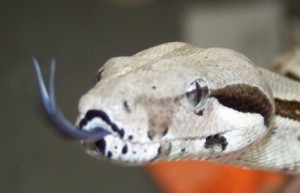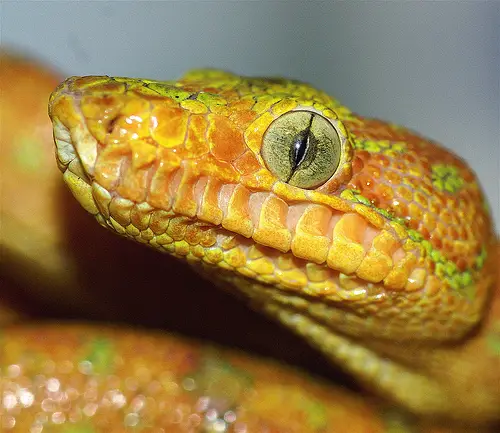Superior Hearing & Vision of Snakes
Table of Contents
The common misconception among people with snakes is that they are deaf. This assumption is mainly due to the fact that a snake has no ear on the outside. They do, however, have inner ears, which gives them the ability to hear well.
 We know sound waves travel invisibly, and therefore we can’t see them. The eardrum experiences vibration from these waves, hitting us at various frequency levels, and the result is we hear something.
We know sound waves travel invisibly, and therefore we can’t see them. The eardrum experiences vibration from these waves, hitting us at various frequency levels, and the result is we hear something.
This is not very different from how snakes hear. The main difference is that those sound wave frequencies are felt in the ground by the snake, whereas the sound waves we hear are from airwaves.
The Basic Design of Snakes Hearing
Anytime something moves across the ground it creates vibrations. This also includes animals and people. Most animals don’t take notice of these vibrations, but a snake does.
When the wave reaches the snake, it is picked up by the bones and muscles in the snake’s lower jaw. These vibrations are focused into an organ called the cochlea that gathers the sound for processing by the snake’s inner ear.
The Advanced Design
It was believed that snakes could “hear” but couldn’t localize sounds for a long time. In other words, they couldn’t pinpoint where something was and had to rely on their poor eyesight and a keen sense of smell to home in on their prey.
Science has discovered that a snake‘s jaw’s elasticity allows it to localize vibrations traveling through the ground, aiding the snake in determining which direction a sound is coming from.
You can find more details about how this works in this article that gives an overview of a study done by the University of Munich and University of Kansas researchers. The overview is that the snakes hinged jaw allows them to pick up the vibrations independently of one another depending on their side.
 According to the study, there is evidence that the snake’s auditory neurons create a topographical map that allows them to pin-point prey by the vibrations they create. In a nutshell, it is a form of echolocation.
According to the study, there is evidence that the snake’s auditory neurons create a topographical map that allows them to pin-point prey by the vibrations they create. In a nutshell, it is a form of echolocation.
Fascinating right? If you are a snake lover like us, we are sure it’s exciting to you also. There are many similarities to humans, and science is continuously uncovering some incredible snake discoveries.
The more we know about snakes, the better we can care for them and give them what they need to thrive in an environment we provide for them.
Snakes See in Stereo
How snakes see is often misunderstood. For instance it is a misconception that snakes are almost blind. While their vision isn’t as acute as a persons they have other tools that work in harmony with sight to give them a very robust image of the world around them. Their hearing, despite a lack of external ears, is superb. They have an excellent sense of smell, so acute that it allows them to track the exact direction their prey is going turn by turn. In addition there some snakes, the most infamous of which are the pit vipers, that have a special infrared vision.

Here are some interesting tidbits of information about a snakes vision.
- Snakes have cones in their retinas; cones is what allows us to perceive color. It is the same for them, but not as vivid nor wide a range. Think in terms of hues and shades
- They have trouble seeing things that aren’t moving. That’s where other senses such as smell (flicking of the tongue), and heat signature (in the snakes equipped by nature for it) come into play
- A snake is very near sighted
- It is NOT true that you can tell a venomous snake by the shape of its pupils
- Many animals were created with a special oil drop that surrounds the cones of the eyes to protect them from ultraviolet light. Snakes instead rely on a filter over the lens of their eyes that can not be penetrated by the uv wave length
- A snake has eyes with a telescoping lens. They can move the lens itself forward and backward (in and out) with muscle contraction/relaxation
- A snake has no eye lids. They have a clear scale over each eye that comes off when they shed their skin
- In general snakes can see better at night because their rods are more highly developed than the cones. Which is the opposite of you and I. The cones in our eyes are better developed and that allows us to see colors in much more vivid tones
- One sign a snake is going to shed is its eyes become opaque about 5 to 7 days before it happens
- Sometimes a shedding snake will not shed the scale on its eyes. This is often a sign that the humidity is too low
